Do not confuse peptide content with the purity. The purity of peptide might be 100% while the related charged group of peptide content such as Arg is decided by anti-iron amount. It is the unique characteristics of synthetic peptide. In terms of the preservation and operation of polypeptide, some tips are as followed.
 1. The preservation of lyophilized peptide and peptide solution
1. The preservation of lyophilized peptide and peptide solution
All products should be stored in the refrigerator, preferably -20℃. Most peptides can be stored in this way for a few years and remain unchanged. Compared with lyophilized peptide, the preservation of peptide solution can be a little complicated. Unstabler than lyophilized form, the solution should be neutral pH and it should apply sample storage in order to avoid repeated freezing. Even if the sample hasn’t been used up after the thawing it should be thrown away, because bacterial degradation sometimes could be troublesome to peptide solution.
2. Reconstruction and operation of polypeptide
Most peptides are dissolved in sterile distilled water. However, the initial concentration should be greater than the desired concentration while conducting the dissolution for the first time. But if the solubility of the peptide in water is limited, there are several options that can help dissolve. Using dilute acetic acid in the basic peptide, using dilute ammonia in the acidic peptide, using 10% organic modifier in the extremely hydrophobic peptide, and guanicline hydrochloride are all the applicant methods. In addition, sonication is also an effective means of dissolving polypeptide.
3. The applications of Polypeptide
As is known, polypeptdie has a wide range of solubility. The main reason that causes insoluble peptide is because of the formation of secondary structure. Actually, except for the largest peptide, any other peptides can appear such issue. It’s more significant in the peptides with multiple hydrophobic residues, while salt will promote the formation of secondary structure to a certain degree. It’s recommended that dissolving polypeptide in the sterile distilled water. Whereas, if the dissolution still faces some problems, then it will be helpful to add a small amount of dilute acetic acid or ammonia.
Polypeptide in solution is far unstable but it is susceptible to bacterial degradation. In sum, the preservation and operation of polypeptide might be a little difficult to accomplish, it’s worthy of a try. Try these tips and you’ll find they are useful in your peptide experiments.